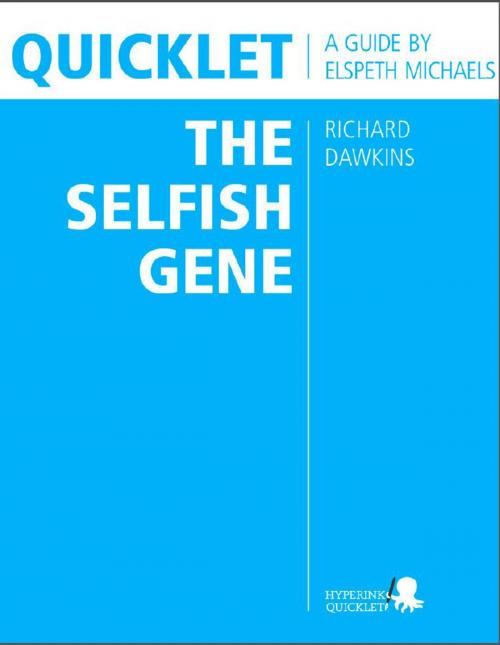Quicklet on Richard Dawkins' The Selfish Gene (CliffNotes-like Book Summary & Analysis): Chapter-by-Chapter Summary and Commentary
Nonfiction, Science & Nature, Science, Biological Sciences, Biology, Evolution, Fiction & Literature, Literary Theory & Criticism| Author: | Elspeth Michaels | ISBN: | 9781614646280 |
| Publisher: | Hyperink | Publication: | July 30, 2012 |
| Imprint: | Hyperink - The Selfish Gene Quicklet | Language: | English |
| Author: | Elspeth Michaels |
| ISBN: | 9781614646280 |
| Publisher: | Hyperink |
| Publication: | July 30, 2012 |
| Imprint: | Hyperink - The Selfish Gene Quicklet |
| Language: | English |
ABOUT THE BOOK
In a 2006 interview with Meet the Author, the year when The Selfish Gene celebrated its 30th anniversary, Richard Dawkins had this to say:
“...If I had to write it again, I wouldn’t write it very differently. It has been described as a revolutionary book, in one respect it is. But it’s only a revolutionary way in looking at orthodox Darwinian natural selection. It helps to look at it in this revolutionary way. It could equally well have been called “the Altruistic Animal,” because if you have selfish genes, which only means that natural selection works at the level of the gene; if you have selfish genes, then you may have altruistic individuals. And that’s what the book is about.”
What Dawkins describes as “revolutionary,” others have construed as controversial. When The Selfish Gene was first published in 1976, it created a number of waves within the study evolutionary biology, largely dominated by Darwinian doctrine. (One could say it made a splash in the gene pool.) If Darwin’s idea of natural selection was based on the concept of “survival of the fittest,” then why does altruism exist between individuals? Why aren’t all living things selfish in a cut-throat battle for survival? Dawkins strove to explain altruism in The Selfish Gene, with the argument that altruistic behavior can be explained through the selfishness of our genes.
EXCERPT FROM THE BOOK
If it runs away, chase it! If it comes at you, fight back.) In a relationship such as prey versus predator, Dawkins explains possible strategies. A retaliator doesn’t attack aggressively, but will act in a threatening manner. If the opponent attacks first, the retaliator will, as you guessed, retaliate. Retaliators behave based upon their opponent’s behavior, making them conditional strategists. In addition to retaliators, there are two other kinds of conditional strategies: bullies and prober-retaliators. A bully attacks until an opponent strikes back, in which case, the bully immediately retreats. Prober-retaliators are essentially retaliators, but can initiate an attack like a bully, and if the opponent fights back, will defend itself. In these strategies, the retaliator is an ESS, the prober-retaliator is nearly stable, and the bully is not stable.
Chapter 6: Genemanship
The key point of this chapter is that genes might be able to assist replicas of itself that are sitting in other bodies. If so, this would appear as individual altruism but it would be brought about by gene selfishness. (88)
In the previous chapter, Dawkins explained aggression through individual, independent selfish machines. However, individuals have relatives, in the form of siblings, cousins, parents, etc., all of whom share many of the same genes. Each selfish gene then, has its loyalties divided among different individuals; the selfish gene is every replica of itself.
Dawkins explains how a gene selected for kin-altruism, could survive in the gene pool. A gene that suicidally saves five cousins would not be numerous in a population of individuals, however, if it saved five brothers or ten first cousins would. The minimum requirement for a suicidal altruistic gene to be a successful one in the gene pool would have to “save more than two siblings/children/parents, more than four half-siblings/uncles/aunts/nephews/nieces/grandparents/grandchildren, or more than eight first cousins, etc.”
ABOUT THE BOOK
In a 2006 interview with Meet the Author, the year when The Selfish Gene celebrated its 30th anniversary, Richard Dawkins had this to say:
“...If I had to write it again, I wouldn’t write it very differently. It has been described as a revolutionary book, in one respect it is. But it’s only a revolutionary way in looking at orthodox Darwinian natural selection. It helps to look at it in this revolutionary way. It could equally well have been called “the Altruistic Animal,” because if you have selfish genes, which only means that natural selection works at the level of the gene; if you have selfish genes, then you may have altruistic individuals. And that’s what the book is about.”
What Dawkins describes as “revolutionary,” others have construed as controversial. When The Selfish Gene was first published in 1976, it created a number of waves within the study evolutionary biology, largely dominated by Darwinian doctrine. (One could say it made a splash in the gene pool.) If Darwin’s idea of natural selection was based on the concept of “survival of the fittest,” then why does altruism exist between individuals? Why aren’t all living things selfish in a cut-throat battle for survival? Dawkins strove to explain altruism in The Selfish Gene, with the argument that altruistic behavior can be explained through the selfishness of our genes.
EXCERPT FROM THE BOOK
If it runs away, chase it! If it comes at you, fight back.) In a relationship such as prey versus predator, Dawkins explains possible strategies. A retaliator doesn’t attack aggressively, but will act in a threatening manner. If the opponent attacks first, the retaliator will, as you guessed, retaliate. Retaliators behave based upon their opponent’s behavior, making them conditional strategists. In addition to retaliators, there are two other kinds of conditional strategies: bullies and prober-retaliators. A bully attacks until an opponent strikes back, in which case, the bully immediately retreats. Prober-retaliators are essentially retaliators, but can initiate an attack like a bully, and if the opponent fights back, will defend itself. In these strategies, the retaliator is an ESS, the prober-retaliator is nearly stable, and the bully is not stable.
Chapter 6: Genemanship
The key point of this chapter is that genes might be able to assist replicas of itself that are sitting in other bodies. If so, this would appear as individual altruism but it would be brought about by gene selfishness. (88)
In the previous chapter, Dawkins explained aggression through individual, independent selfish machines. However, individuals have relatives, in the form of siblings, cousins, parents, etc., all of whom share many of the same genes. Each selfish gene then, has its loyalties divided among different individuals; the selfish gene is every replica of itself.
Dawkins explains how a gene selected for kin-altruism, could survive in the gene pool. A gene that suicidally saves five cousins would not be numerous in a population of individuals, however, if it saved five brothers or ten first cousins would. The minimum requirement for a suicidal altruistic gene to be a successful one in the gene pool would have to “save more than two siblings/children/parents, more than four half-siblings/uncles/aunts/nephews/nieces/grandparents/grandchildren, or more than eight first cousins, etc.”















